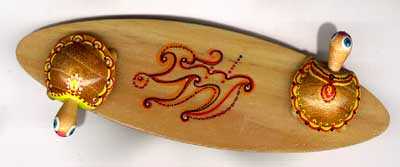Rattleback mystery explained
A rattleback, also called a celt or wobblestone, is an interesting little piece of material with a roundish bottom and an unbalanced distribution of weight. When spun, it will soon start to rock and then, as the rocking motion subsides, it will settle down to spinning in the reverse direction. Rattlebacks do not work well on a slippery surface, which means that a certain amount of friction is a necessary condition for it to work...

There are several videos on YouTube that show the spin reversal we see in a rattleback. You can start with this one and see below or check the "related videos" on the YouTube page for more.
http://www.youtube-nocookie.com/watch?v=puaif3OTJL4&feature=related
http://www.youtube-nocookie.com/watch?v=PydoEA5Jx5s
Wikipedia about the rattleback: "This spin-reversal motion seems, at first sight, to violate the angular-momentum conservation law of physics. Moreover, for most rattlebacks, the motion will happen when the rattleback is spun in one direction, but not when spun in the other. Some exceptional rattlebacks will reverse when spun in either direction. This makes the rattleback a physical curiosity that has excited human imagination since prehistorical times."
I was first made aware of the existence of this curiosity by David Tombe, who mentions rattlebacks in some of his article and tries to explain their spin reversal with reference to the coriolis force. In the latest revision of one article titled The Cause of Coriolis Force (http://www.cartesio-episteme.net/ep8/vorticity--new.pdf) Tombe's treatment of the rattleback starts out like this:
The rattleback is the most mysterious of all the mechanical devices. A spinning rattleback undergoes a complete 180 degree reversal of its angular momentum without any apparent source of reversal torque. The situation is further complicated by the fact that some rattlebacks can work in both directions. Modern physicists cannot explain the rattleback mystery because they deny all three of the vital ingredients that are necessary for its full understanding. We first need centrifugal charge followed by axial Coriolis force. We also need the electric sea in order to induce these convective effects, and also to give the reversal torque something to kick off against, as per Newton's third law of motion. The rattleback is very obviously tangled up in a very subtle elastic medium, but this medium along with the centrifugal force and the axial Coriolis force which are the basis of the interaction with this medium, are denied in modern physics.
In a March 2011 email, David Tombe sent a link to a new, much simplified article explaining the rattleback. The new article, titled "The Coriolis Force and the Rattleback" can be found here: http://www.cartesio-episteme.net/ep8/reversaltorque.pdf
My own take on the reversal of spin of the rattleback is that it is due to the interplay of known forces - inertia, gravity and friction. How exactly? If you check on the net, several people say they understand how the rattleback works, but I have yet to see a clear and simple description of the mechanics and the forces involved.
So here is my attempt to give a point for point explanation of the process of torque reversal in the rattleback ...
- - -
My view on the operation of the rattleback
No unknown forces are needed to engineer the reversal of spin. All we need are the initial input that sets the rattleback in motion, inertia which tries to keep it in motion and friction which slows down the rotation and ends up giving way to a rocking phase. There is an interplay of gravity and inertia during the rocking phase, which combined with an imbalance of weight distribution induces a circular, instead of a simple up-and-down rocking motion. The principle of least action that constantly seeks to balance these various forces, always taking the most easy path, eventually leads to a reversal of the original spin that set the rattleback in motion...
1) acceleration is supplied by the initial push that sets the rattleback in spinning motion. Inertia tends to perpetuate that motion.
2) friction counters the motion, supplying a decelerating force that over time would force the rattleback to come to a standstill, if it weren't for an imbalance in its weight distribution...
3) before the rattleback can come to a standstill, the unbalanced weight distribution of the rattleback works towards evading the friction by inducing a rocking motion.
4) soon we have all the energy that remains from the initially supplied push to the rattleback transformed from rotation to rocking motion. This kind of motion is an interplay between inertia and gravity, where gravity and inertia will continually overcompensate. The tendency is to just keep rocking, friction is reduced to almost nothing.
5) this rocking motion would in time exhaust itself, leaving the rattleback motionless, if it weren't for the imbalance in its weight distribution giving a circular component to the rocking motion...
6) the circular component of the rocking motion induced by the imbalance of weight distribution will now transform that rocking motion back into a rotating motion - again with the help of friction - which works to induce a reversal of spin.
7) We now have a spinning motion again, much slower than the original, and in the reverse direction. It was friction and imbalance that worked together to engineer this reversal of motion, with the help of inertia.
It is a bit as if you took a spinning ball and changed its axis of spin by 180 degrees. It would be continuing to spin, only now it appears to spin in the opposite direction.
Similarly, in the rattleback, the originally supplied spin is transformed into rocking motion and then back into spin, now in the reverse direction.
How to make your own rattleback
If you want to experiment with this, you can do so simply by using ...
http://www.planet-scicast.com/view_clip.cfm?cit_id=2685
or
http://www.exo.net/~pauld/activities/sweden/spoonrattleback.html
Update July 2014:
Here is a description by Brian Lewis, who analysed the movement of a rattleback and shared it with us...





I've lost a lot of sleep over this curious toy (which is new to me) but I think it's epicyclic. When a tilted cup rolls round a circle larger than its base with the axis of spin preceeding clockwise the body of the cup, as indicated by the handle, rotates anticlockwise. If the cup body is given a clockwise spin to start with it skids (rattles) round the epicycle, losing spin due to friction as you describe, Sepp, until it stops and then uses whatever inertia is left in the system to briefly revert to anticlockwise as before. In order not to tumble over the shape must be shallow, like a spoon or boat. The 'rocking of the boat' is due to the precession of the axis of spin being exaggerated across the narrow part of the hull.
Now for the practical. Roll back the carpet and grab a plate. Some work better than others and some just won't work at all. One that works every time for me is of thin glass 215mm in diameter with no annulus on the base which has a 150mm diameter flat before rolling up to form a shallow rim. Spin the plate with a flick of the wrist onto a hard floor. It skids, then wobbles (i.e. precesses as explained yesterday) and finally turns briefly in the opposite direction. There's no mystery. It's a simple epicyclic process most easily understood by repeating it with the plate turned upside down. It doesn't work so well as before but the mechanism is now obvious.
A symmetrical plate can't be made to rotate by vertical pressure on its rim. This animation shows how this works for some asymmetrical rattlebacks:
http://www.technologystudent.com/cams/swash1.htm
I am disappointed at all this OPINION expressed concerning how it works.It just can't be that hard to analyze in terms of Lagrangian mechanics. Isn't that what Bondi's article does? It is Proc. R. Soc. Lond. A 405, 265-274 (1986)
I have found Bondi's article here
http://www.jstor.org/pss/2397977
but only the first page. Perhaps someone can locate a copy that everyone could check up without having to pay for access? Post here if you do find it, please.
About finding Bondi's article: it would be a violation of copyright to put it for free anywhere, so I gave up on looking for that. I did find, however, that many universities and even some public libraries have JSTOR access. You can see the whole thing by using your library card to log in to a participating library's website and read the whole thing that way.
Sorry, I can't remember the Google query I used to find the list of participating institutions: I also searched the JSTOR site. They have a list of participating institutions, but it is poorly organized, so I could not find one near me using that.
Finally, let me note that Bondi made NO reference to any contribution from the Coriolis force.
blast copyright ... why do they think they have to hide away information that's interesting to everyone behind pay walls and "don't copy" signs?
It seems we are under the thumb of those who would monetize our whole lives, if they could.
And by the way, copyright is supposed to protect against anyone taking your content and running off to make a business with it. There IS such a thing as educational and fair use. After all, it IS our culture.
The copyright fiends have gone so far as to prohibit anyone even from knowing what's written, rather than the original prohibition to make copies for *commercial* purposes.
We will wait until the copyright expires, or until copyright laws are re-interpreted in their original sense to prohibit commercial use of copyrighted material, not educational use or someone satisfying their curiosity.
Please don't turn the comments on this post into a forums for anti IP rants. Sure, there are real problems with the way IP has been done for the last 50-100 years, but this is not the place for discussing it. The Volokh Conspiracy is a better place for that. This is the place for discussing rattleback physics. If you have a library card, you might be able to access the Bondi article from the comfort of your home office. If you don't even have a library card, then, what can I say?
Now speaking of rattleback physics, I did read the Bondi article, but only scanning it quickly. And I found yet another online source that at least shows the Lagrangian for a rattleback. It is "Nonholonomic Control" by Anthony Bloch, available in "limited preview" on Google Books. Look at p. 43
Their choice of coordinates is a little weird, but I can see the gyroscopic terms whose presence explains kinetic coupling between rotating motion and wobbling motion. What I can tell by repeated experiment with my one one rattle back is that rotating in the "wrong way" almost always causes wobbling. The wobbling then grows, but then dumps all its kinetic energy into the 'favored' direction of rotation. This reminds me of the physics lecture/demo where the lecturer spun a book in the air, showing how spinning around ONE principal axis was stable, around another very unstable. I am sure the analogy is no accident, but without a more precise description of what the principal axes look like for a rattleback, I did not pursue this further.
Oh, and on my sample rattleback at least, it is very noticeable: even when resting motionless, it lists to one side and even with a slight pitch. So the principal axes are not where you would think they are when looking at it, they are skewed. That must help making it so difficult to set it spinning without also starting the wobbling. And once the wobbling starts, it does as described above.
Sorry for my copyright outburst. You are right, I will leave that discussion out of this particular place.
I concur with what you say about the functioning of the rattleback.
Although I did reference Tombe's take on the rattleback, who cites the Coriolis force as responsible, I do not agree with him and in my own take on it I have given what I see as a purely mechanical explanation.
I found Bondi, The rigid body dynamics of unidirectional spin. It's a scanned PDF of the article and it's available here:
http://www.chem.ucsb.edu/~devries/chem218/blue%20rock%20math.pdf
I am posting this for Patrick GALIOT, a reader who commented by email...
"I am a retired physics teacher, helping some pupils taking part in the "Olympiades de la Physique", in France. A boy (17 years old) wanted to study the rattleback (anagyre, in French), and its "unexpected motion".
I came upon your blog, and was deeply interested in your ideas. Consequently, I tried to understand the motion of the rattleback, which seems to work like an asymmetrical top. I was very much helped by an explanation in "Physics for Scientists and Engineers with Modern Physics" written by Douglas C. Giancoli, published in 1989 by Prentice-Hall Inc., Englewood Cliffs, New Jersey, and translated into French by Les Editions de la Chenelière inc. (Montreal), particularly in his study of an unbalanced wheel.
I considered a very simple rattleback, like seen in your picture : half an homogene ellipsoïdal body + 2 ponctual masses symmetrical (the heads of the 2 turtles, for exemple) on the edge of the base ellipse.
When you push the end of the rattleback to set it into clockwise motion, it rolls a little, while spinning around a vertical axis CG (C point of contact on the table, and G centre of mass of the asymmetrical rattleback). So, the angular momentum vector forms an angle with the angular speed vector which is along the vertical axis CG. Consequently, according the theorem of the angular momentum, relatively to G, a horizontal force F (i.e. a friction) becomes necessary.
In a clockwise spin, this force is directed to the left, and increases the rolling, making the motion instable. On the opposite, in an anticlockwise spin, this force is directed to the right, and corrects the rolling, to the point of verticaly alining the 2 angular vectors, making the rotation stable, until the friction torque stops it.
According to the energy conservation principle, the initial spinning energy is, at the end of the unstable motion, turned into pitching energy, which is, after, turned into spinning energy, in the stable [direction of] motion.
Of course, the friction torque, progressively turns this cinetique energy into heat, and the motion stops !
So, no need for centrifugal or Coriolis forces (we describe the motion relatively to the table) ! Only, an adequate friction force at the contact point C, whose direction changes, according to the spinning direction, first making it unstable, and after stable. The transition being a pitching motion, helped by a little rolling motion !"
Brian Lewis writes an email saying he has analysed the movements of the rattleback...
Hello Sepp,
A few weeks ago I watched a TV show called QI during which a rattleback was demonstrated as an item of interest that worked in a way nobody fully understood.
I thought that I would find on the internet an explanation of how the rattleback worked but, apart from your description on your blog website, I couldn't find anything that I could understand.
I made a rattleback to experiment with and eventually satisfied myself that I knew how it worked. I have written an account of how I think it works which includes a simple, practical method of confirming the spin reversal process. I think that the principles are much as you outlined, so I thought you might find it of interest. I have attached the document to this email.
I would welcome your comments. If you feel that my description deserves serious consideration, I have no objection to your copying it to other people.
Apologies, if I am intruding on your time, but you did give an email contact address so I feel that you may expect some correspondence even though your article was written several years ago.
Regards,
Brian Lewis
p.s. (by Sepp)
I have uploaded the file Brian sent and it's linked at the end of the article now, just before the start of the comments